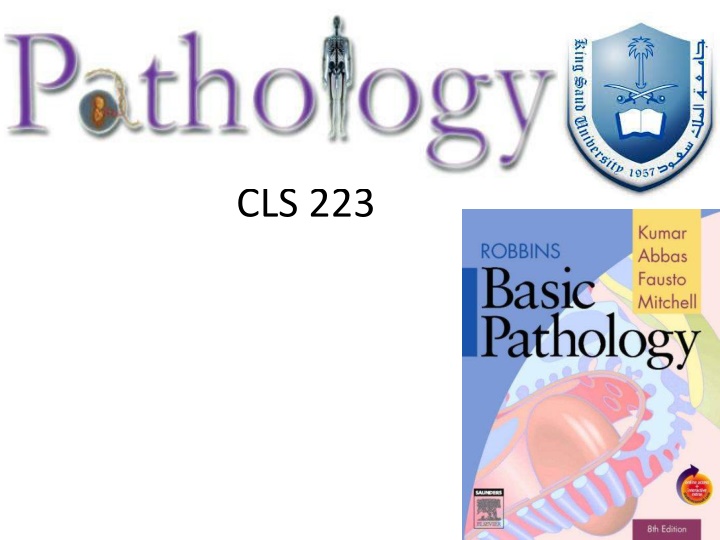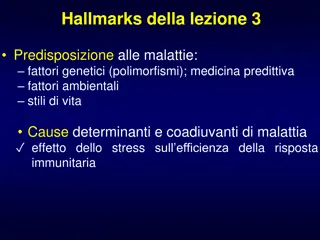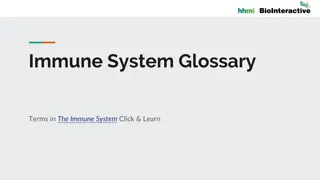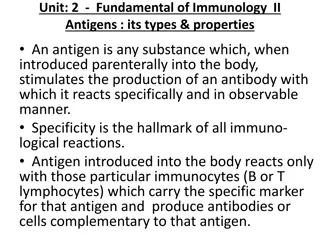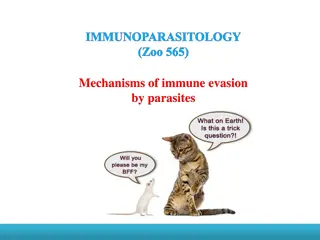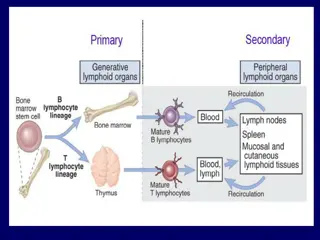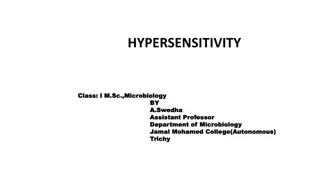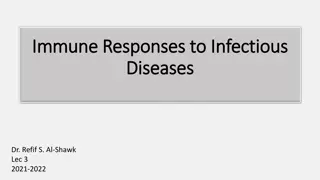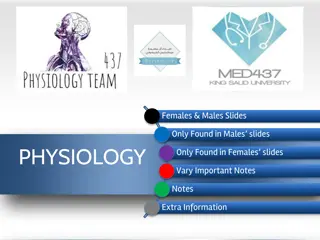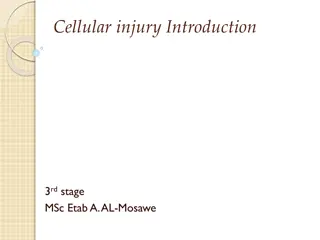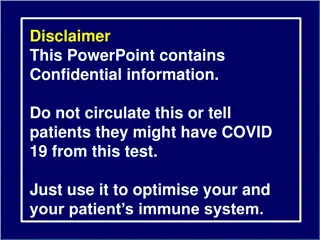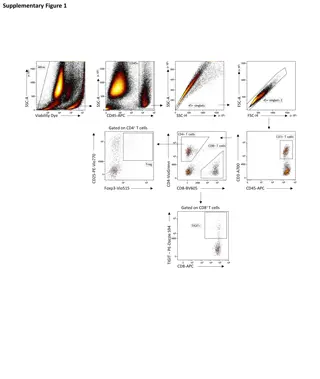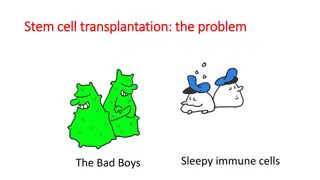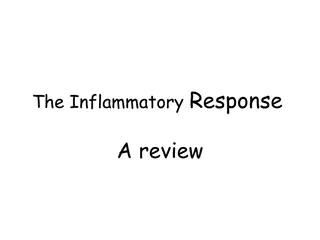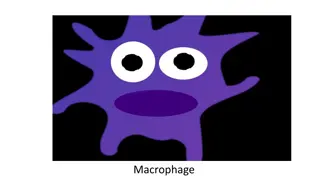Cellular Response and Immune System Overview
Cellular response to stress can be adaptive or non-adaptive, leading to various changes in cell structure and function. Understanding immunity, protection against pathogens, and defense mechanisms are essential for overall well-being. Learn about antigens, immunoglobulins, and the three lines of defense in the immune system for a comprehensive overview of cellular responses and immune function.
Download Presentation

Please find below an Image/Link to download the presentation.
The content on the website is provided AS IS for your information and personal use only. It may not be sold, licensed, or shared on other websites without obtaining consent from the author.If you encounter any issues during the download, it is possible that the publisher has removed the file from their server.
You are allowed to download the files provided on this website for personal or commercial use, subject to the condition that they are used lawfully. All files are the property of their respective owners.
The content on the website is provided AS IS for your information and personal use only. It may not be sold, licensed, or shared on other websites without obtaining consent from the author.
E N D
Presentation Transcript
Lecture # 5 Immune Response
Cellular response to stress Cellular response to stress may be adaptive or non adaptive. Adaptive Non-adaptive (cell injury-----cell death) hypertrophy Dysplasia 1) Change in cell number, size, type hyperplasia neoplasia Atrophy Degeneration Metaplasia Necrosis, apoptosis & gangrene Reversible Reversible* / Irreversible 2) Inflammation and repair 3) Immune response *to a certain limit
Immune response Immunity: is the ability of an organism to recognize and defend itself against specific pathogens or antigens.
Protection against invading pathogens: 1) First line of defense: non-specific natural barrier which restrict entry of pathogen. E.g.: Skin and mucus membranes 1) Second line of defense: non- specific Innate immune defense provide rapid local response to pathogen after it has entered the host. E.g.: inflammatory response, WBC Phagocytes (macrophages, neutrophils). 1) Third line of defense: Antigen specific immune response, specifically target and attack invaders that get past first two lines of defense. E.g.: Antibodies and lymphocytes.
Non specific defense mechanism Specific defense mechanism (immune system) 3rd line of defense 1st line of defense 2nd line of defense Skin Mucus membrane Inflammation Phagocytic WBC Lymphocytes Abs Immunity Natural, innate, non specific Examples? Acquired, specific, adaptive
Antigen Antigen (immunogen): is a substance recognized by the immune system stimulating an immune response. Hapten: a small molecule that can not induce an immune response (non- immunogenic) unless attached to a large carrier such as protein
(immunoglobulins, Igs): They are formed by the plasma cells which are derived from B-lymphocytes. There are 5 types of Igs: 1) IgA- in secretions; saliva, tears, mucous, breast milk Localized protection of mucosal surfaces. immunity to infant digestive tract. 1) IgD- function not well understood. 2) IgE- it releases the histamine from the Mast cells and Basophils. Protects against parasitic warms and allergic reactions. 3) IgG- most versatile in function, released after IgM, can cross placenta. 4) IgM- it is the primary response against infection. Antibodies
epitope They are the antigenic determinants. The smallest part of the Ag recognized by the Ab.
Specific, acquired Immunity It is divided into: 1) Active immunity: B- cells of the subject himself will be stimulated to produce his own antibodies. -Active immunity can be naturally or artificially acquired. 2) Passive immunity: Antibodies were prepared in other subject or animal and then will be given to the subject needed to be immunized. -Passive immunity can be naturally and artificially acquired.
Immunity Acquired, specific, Natural, innate, non specific Naturally acquired Artificially acquired passive Active passive Active Ab pass from mother to fetus via placenta or to infant in milk Vaccine* -dead -live attenuated -toxoid Injection of immune serum (gamma globulin) Infection* (contact with pathogen)
Infection* Infection gives either: 1)Long-life immunity: Some infections when occur produce long life immunity against this infection and not to others. E.g. Infection by small-pox produces long-life immunity against the small pox only and not any other infection. 2)Short-life immunity: as in common cold, influenza,,,
Vaccine* The vaccine may be: -Inactivated/Killed: made of micro- organisms that have been destroyed with chemicals, heat, radioactivity, or antibiotics as in hepatitis A. -Live attenuated: made of active viruses that have been cultivated under conditions that disable their virulent properties as in small pox, measles, rubella, yellow fever, influenza. -Toxoids (inactivated toxin): made from inactivated toxic compounds rather than the micro-organism itself as in diphtheria, tetanus.
Types of adaptive immune response: 1) Humoral immune response: the responsible cells are B-lymphocytes produce plasma cells form the Igs. 2) Cell mediated immune response: the responsible cells are the T- lymphocytes. Stimulated T lymphocytes affect the antigen by direct cytotoxic affect; producing cytotoxic factors that directly kills the antigen.
Humoral immune response B lymphocytes has membrane bound antibodies that will bind to specific antigens. The binding event activates the B lymphocyte to produce large number of clones (replicates) primary humoral response. Most B cells become plasma cells that produce specific Abs that bind to Ag (Ag-Ab complex) destroy that specific Ag. Or phagocytic cells recognize the Ab-Ag complex and engulf it. Some B cells become long-lived memory cells secondary humoral response)
Immune response my be primary or secondary
Primary immune response When there is an attack with an antigen for the first time, activation of B-lymphocytes occur resulting in production of low amount of antibodies leading to destruction of the antigen. This immune response takes time to develop. The body gets specific immune state which may last for years (y?).
Secondary immune response When there is a second contact with the same antigen, there is a rapid activation of immune response and there is production of high amount of antibodies. Rapid destruction of antigen occurs with no disease production.
https://www.khanacademy.org/science/biolog y/immunology/v/types-of-immune-responses- innate-and-adaptive-humoral-vs-cell- mediated https://www.khanacademy.org/science/biol ogy/immunology/v/b-lymphocytes-b-cells
